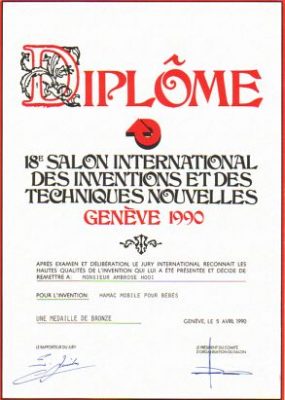Awards, Tests & Standards

BSI – British Standards – Report no. FP200219 -> Approved
There shall be no open end tubes, projections, holes, loose washers, nuts or crevices in which a child’s finger(s) or flesh could be trapped when the Natures Nest is assembled for use. All edges, corners and projecting parts that are accessible shall be free from burrs and shall not be capable of causing a wound or abrasion.
Assessment: Pass
Any permanent fixture that can be gripped by a child’s fingers or teeth shall be attached to the Natures Nest in such a manner that it cannot be removed or broken when a force of 90N is applied in any direction to the part.
Assessment: Pass
The following test is taken from BS 5799: 1986 Safety Requirements for children’s high chairs and multi purpose high chairs for domestic use. See Clause 5,8,1-Appendix M. The above states that when tested by the method in Appendix M the frame shall not tip over. Assessment : Pass
The details of the 15 kg test dummy used were stated in Appendix E of the above specification
The strength of the Natures Nest frame was assessed by attachment of a 40 kg load to the high tensile spring for a period of one hour. The load was then removed and the frame steel tubing and spring were inspected for any structural damage or permanent distortion.
Assessment : Pass
The strength of the Nest bed (hammock) and metal cross strut was assessed by placing a load of 25 kg evenly across the mattress while suspended from the spring for a period of 8 hours. The load was then removed and the Nest bed and metal cross strut were inspected for any structural damage or permanent distortion.
Assessment : Pass
The instructions supplied were considered to contain adequate information on it’s safe use, assembly, operation and maintenance.
The instructions were written in English.
Prepared by : P. Smith
Authorised by : R J Hardy
Issue date: 18th August 1993
British Standards Institution (BSI)
BSI Healthcare and Testing Services.
Kitemark House, Maylands Avenue, Hemel Hempstead, HP2 4SQ, United Kingdom,
Telephone: +44 (0)845 080 9000
Email: product.services@bsigroup.com
Japan Misc Goods Safety Lab – Report no. 9201673 -> Approved
JMGSL – Japan Miscellaneous Goods Safety Laboratory – Report No. 9201673
Product Name Tested : Amby Natures Nest Baby Hammock
Stability Test
Measure the angles when the unit falls down frontwards, backwards, rightward and leftward.
Testing method:
Loads of 1 kg, 2 kg progressively up to 15 kg were used. The angles were then measured when the unit falls frontwards, backwards, left and right.
Assessment: Pass – The frame did not topple over at any weight and in any direction.
Withstand load test
Testing method:
A load of 5 kg was placed in the hammock. The displacement of the frame and the extension of the spring were measured and checked for anomilies each time when a 5 kg load was put accumulatively on the cloth of the ‘nest’.
Assessment: Pass – No anomily was detected in all tests.
Load strength test
Testing method:
Place all units as shown. Put up to 50 kg load to the spring and measure the displacement in the directions of ‘a’ and ‘b’ and the extension of the spring. Then check for anomalies and measure the displacement after the load was removed.
Assessment : Pass – No anomilies were found either in spring or distortion of frame
Test item: hammock sling
The fabric used for the hammock was tested for
(a) Light fastness ………………..JIS L 0842
(b) Perspiration …………………….JIS L 0848 -A: method acid A: method alkali
(c) Friction ………………………….JIS L 0849 . II type
(d) Shrinkage percentage………..JIS L 1042 G method line dry
Assessment: Pass – The results described above comply with the standard of the textile product for babies (under 24 months) The products defined by the law are diaper, diaper cover, bib, underwear, pyjamas, gloves, socks, jacket, hat and sleeping material.
New Zealand – Carbon Dioxide Test (rebreathing) -> Approved
Medical School, University of Otago, N.Z. -Carbon Dioxide Test (rebreathing)
Baby Hammock Test Results: Carbon Dioxide Testing
Hammock was tested with a mechanical model of a 3 month old infant. This model breaths warmed, humidified gas with an end expiratory plateau of 5% carbon dioxide The head of the model was placed face up, face to the side and face down in the hammock.
Results face up: There was no significant increase in inspired carbon dioxide
Results with face to the side: Not touching side material, inspired carbon dioxide rose to an average of 0.32%. Touching the material, inspired carbon dioxide rose to an average of 1.28%
Neither of these levels would be considered dangerous.
Results face down: Very variable as it was difficult to keep the model face down, without it rolling back to it’s side or back.
Assessment: Pass
Overall there is minimal danger of rebreathing even if a baby rolls on to it’s side against the material. We would like to see a warning on the package not to place babies in the hammock on their front (prone). Because of the design of this product we think it unlikely that a baby will roll on to the prone position or willingly sleep prone in this product
Dept of Paediatrics & Child Health Medical School, University of Otago, Dunedin, New Zealand
International Inventions – Award for Best Design
International Exhibition of Inventions and New Techniques Geneve, Switzerland – Grand Jury Award for Best Design

